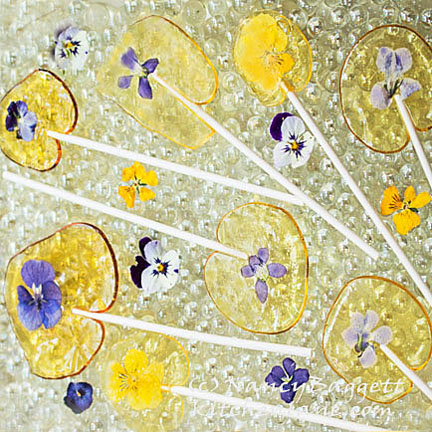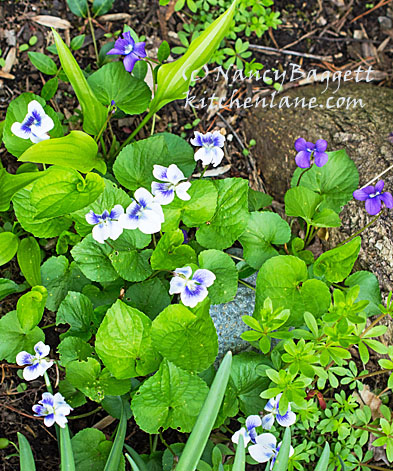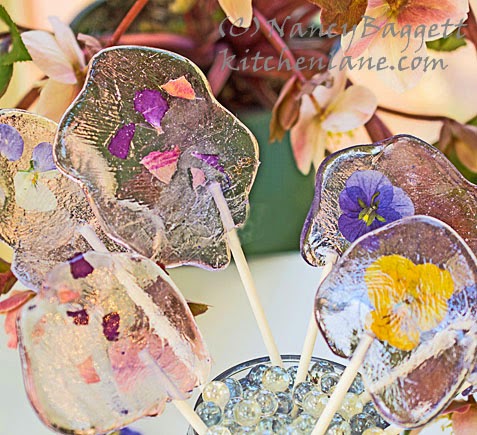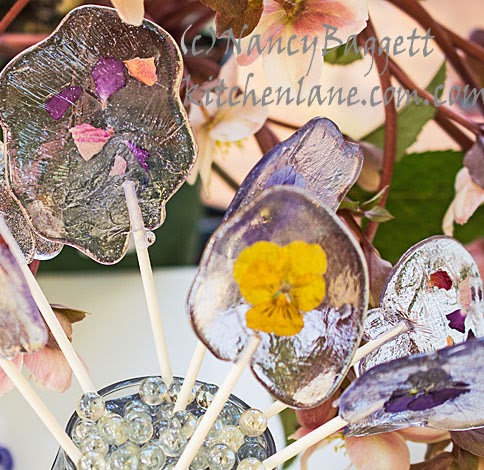 I love how after a long dreary cold spell the snow fades away, the days lengthen, and finally, the early perennial flowers like snowdrops and violets start to poke through the earth and bloom again. They are an early sign that what some societies still call “the starving time,” due to empty larders is past. The first blooms are my favorite harbingers of spring, reminding me that we’ll soon be reveling in fresh bountiful crops like strawberries and rhubarb and rejuvenating in warm, sunny days. One of my favorite ways to use the edible woodland violets that appear in my shade garden, shown at left below, is to make homemade lollipops–they are so whimsical and fun! (Note that spring woodland violets are not the same as the popular violet houseplants–the houseplant violets are in an entirely different plant family and are not edible.)
I love how after a long dreary cold spell the snow fades away, the days lengthen, and finally, the early perennial flowers like snowdrops and violets start to poke through the earth and bloom again. They are an early sign that what some societies still call “the starving time,” due to empty larders is past. The first blooms are my favorite harbingers of spring, reminding me that we’ll soon be reveling in fresh bountiful crops like strawberries and rhubarb and rejuvenating in warm, sunny days. One of my favorite ways to use the edible woodland violets that appear in my shade garden, shown at left below, is to make homemade lollipops–they are so whimsical and fun! (Note that spring woodland violets are not the same as the popular violet houseplants–the houseplant violets are in an entirely different plant family and are not edible.)

Woodland native violets in my garden
The clear, free-form candy pops instantly form paperweight-like cases that capture and show off the shades and graceful shapes of the petals and flowers. The lollipops here feature both woodland violets and organically grown dainty-faced pansies and Johnny-jump-ups, as well as bits of dried rose petals saved from last summer’s garden. Since I’m always hoping to come up with pleasing pastry decorating ideas that rely on only edible flowers and natural botanical colors and that avoid all the risks of artificial food dyes, I’m really pleased with these.

I prepped the blooms by placing them between triple thicknesses of paper towels, then weighting them down and flattening them under a heavy book for several days until completely dry. This step is particularly important for making the flowers lie flat enough to be completely covered with the candy “glass.” BTW, the candy at the top looks yellow simply because it was cooked until it was beginning to caramelize.
In case you are wondering, the flowers have very little taste and most people eat the flecks without even noticing. Others like to deliberately bite off and munch the petals. And still others prefer to carefully break off the pieces with the flowers and discard them.
Lollipop sticks are usually stocked in the cake and pastry decorating sections of discount department stores and in some craft stores or kitchen shops. In a pinch, use wooden Popsicle sticks instead—the lollipops won’t look quite as elegant, but kids never care! Also, expect the pops to come out in natural free-form shapes rather than perfectly round. Even on a tray with a perfectly flat surface, the molten syrup tends to run out unevenly. But the randomness just contributes to the charming homemade look.
There is one important caveat to always remember when making these lollipops or any other hard candy: The boiling sugar mixture is extremely hot. Never try to touch it or taste it while cooking or pouring. And take care never to splash it on your skin. If it drips on the counter top or stove, wipe it off with a wet, warm cloth, never your hand. If you have it, use a heavy cooking pot with a lip for pouring. This will facilitate pouring the molten candy from the pot.
- Assorted small edible flowers and petals, such as organic pansies, roses, or woodland violets
- 1⅓ cups granulated sugar
- ⅓ cup light corn syrup
- ⅓ cup warm water
- ¼ teaspoon raspberry extract, rose extract, or lemon extract
- Drops of botanical food dye, optional
- Ready the flowers or petals by gently but thoroughly washing and patting them dry. Flatten by placing them between triple thicknesses of paper towels, then weighting them down under a heavy book or stack of books overnight or longer. Very gently peel them from the paper before using.
- Set out a 2-cup heat-proof glass measure. Set out a very large flat tray or baking sheet (or 2 smaller sheets) and line with heavy-duty foil. Place 12 to 15 lollipop sticks on the foil, spacing to allow for the candy to spread out to at least 2½ inches in diameter and preferably more. Place the flowers or petals attractively around the top end of the sticks. Set out a heat-proof bowl of ice water.
- In a heavy medium-sized saucepan thoroughly stir together the sugar, corn syrup, and water. Bring the mixture to a boil over medium-high heat, stirring. Cover the pot and let the trapped steam wash any sugar crystals from the pot sides for 2 minutes; lift up the pot from the heat and swirl the mixture several times. Remove the lid. With a wet pastry brush or damp paper towel, wipe away any sugar crystals clinging to the pan sides.
- Continue cooking, never stirring, but lifting and swirling the pan to redistribute the syrup every minute or so. When the syrup has boiled down about 5 minutes, start checking with the candy thermometer. As soon as the syrup registers 305 degrees F, immediately remove the pot from the heat. Quickly add the extract and drops of botanical dye (if using) and swirl the pan until blended in fairly well. Immediately set the pan in the bowl of ice water to stop the cooking and lower the temperature; let stand for 5 minutes, lifting and swirling the pan several times.
- Carefully turn out the cooling syrup into the 2-cup measure. Start forming the lollipops by pouring the syrup over the center tops of the lollipop sticks; sure not to touch the mixture. Continue at a steady pace until all the pops are formed. If at any point the syrup cools and stiffens too much to pour, place the measure in the microwave oven and reheat the mixture for 5 to 10 seconds, or until it is just fluid again. Don’t try to scrape out any left in the cup, as it may turn gritty and cloudy.
- When all the pops are done, slide the baking sheet into a refrigerator and let the candies cool and chill thoroughly. Then, gently peel each one from the foil as needed. Wrap them individually in non-stick clear plastic wrap or special hard candy wrappers. Stored in a cool dry spot, they will keep for several months.


When do you add the flowers?? I didn’t see that step in this recipe.
Yes, I walk around the garden everyday to see what is new. If I am in stalling mode, I stop and do a little weeding!
Well, this is my second try. Sigh. I would never have thought of putting spring flowers in lolly pops, but I am like you in another way. I'm going out every day now to see what's coming up in the garden.
This looks like a really fun project. I would never have thought of making spring flowers into lolly pops. But I am like you with the garden. I go out every day now to see what's coming up.